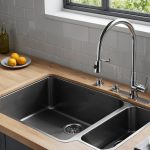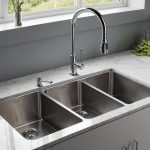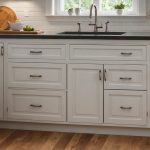Late-night snacking often derails our health goals, but smart kitchen design can make a difference. By strategically arranging your space, it becomes easier to resist those tempting snacks. Consider using hidden compartments, adjustable lighting, and designated eating zones. These elements not only enhance aesthetics but also promote healthier habits. Discover how simple design tweaks can transform your kitchen into an environment that supports mindful eating and curbs unhealthy cravings.
Introduction to Smart Kitchen Designs
In the realm of Smart Kitchen Designs, the connection between layout and eating habits is significant. A well-thought-out kitchen can subtly encourage healthy eating by making nutritious options more accessible. For instance, placing fruits and vegetables at eye level in the refrigerator can prompt healthier choices.
Also to discover : Selecting Kitchen Cabinet Handles: A Key Strategy for Preventing Cross-Contamination
Kitchen aesthetics also play a crucial role in fostering a healthy environment. A visually appealing space can inspire individuals to spend more time preparing meals, which often leads to healthier eating habits. The use of calming colours and natural materials can create an inviting atmosphere, encouraging family gatherings and shared meals.
Functionality is another key aspect of smart kitchen designs. An organised kitchen that minimises clutter can discourage unhealthy snacking. For example, storing snacks in less accessible areas can reduce impulsive eating. A well-designed kitchen layout ensures that cooking tools and ingredients are within easy reach, making meal preparation more efficient and enjoyable.
In essence, smart kitchen designs are not just about aesthetics or technology; they are about creating a space that supports a healthier lifestyle through thoughtful design choices. By focusing on accessibility, aesthetics, and functionality, a kitchen can become a hub for promoting well-being and healthy eating habits.
Key Elements of a Smart Kitchen Design
In the world of Kitchen Design Elements, certain features are pivotal in promoting healthy eating. For instance, incorporating an open shelving system can make healthy ingredients more visible and accessible, encouraging their use in daily meals. This functional layout is essential for ensuring that nutritious options are always within easy reach, thus supporting healthier eating habits.
A Functional Layout is not just about accessibility; it also involves the strategic placement of kitchen appliances. Positioning the refrigerator, sink, and stove in a triangular formation can streamline cooking processes, making meal preparation more efficient. This layout reduces unnecessary movement, allowing for a smoother cooking experience.
The Aesthetic Appeal of a kitchen significantly influences its environment. Choosing calming colours like soft blues or greens can create a serene and inviting atmosphere. Natural materials such as wood and stone add warmth and texture, making the space more comfortable and pleasant to spend time in. These aesthetic choices not only enhance the kitchen's visual appeal but also inspire culinary creativity and encourage family interactions.
Incorporating these key elements into a kitchen design can transform it into a space that not only looks good but also supports a healthier lifestyle.
Color Schemes and Materials That Promote Wellness
Choosing the right kitchen colors can significantly impact eating behaviour, as colour psychology suggests that certain hues can influence mood and appetite. For instance, soft blues and greens are known to create a calming effect, reducing stress and promoting mindful eating. These colours can help in maintaining a relaxed environment, encouraging healthier food choices.
On the other hand, vibrant colours like reds and oranges can stimulate appetite, which might not be ideal for those looking to control their eating habits. Therefore, selecting a color palette that aligns with your wellness goals is crucial. Consider incorporating neutral tones with subtle accents of calming colours to create a balanced atmosphere.
Healthy materials also play a vital role in promoting wellness within the kitchen. Opting for natural materials such as wood and stone not only adds warmth and texture but also contributes to a cleaner and more inviting space. These materials are often more sustainable and can enhance the overall aesthetic appeal of the kitchen.
In summary, integrating thoughtful color schemes and materials can transform a kitchen into a space that supports well-being and encourages healthy eating habits. By understanding the impact of color psychology and choosing the right materials, one can create an environment conducive to wellness.
Innovative Storage Solutions for Healthy Snacks
In the quest for a healthier lifestyle, kitchen storage solutions play a pivotal role in managing snack choices. By creatively organising your kitchen, you can keep unhealthy snacks out of sight, reducing the temptation to indulge. One effective method is to use opaque containers for less healthy options and transparent ones for nutritious snacks, ensuring that the latter are always visible and within reach.
Snack organization can be further enhanced by dedicating specific shelves or drawers to healthy snack options. This not only makes them more accessible but also encourages mindful eating. Consider using stackable bins or tiered shelves to maximise space and keep your kitchen tidy.
Labels are another valuable tool in snack management. Clear and concise labels on containers can help you quickly identify healthy choices, making it easier to grab a nutritious snack on the go. This method also assists in maintaining an organised kitchen environment, as it prevents clutter and confusion.
By implementing these innovative storage solutions, you can create a kitchen that supports healthier eating habits. The right combination of containers, labels, and strategic organisation can transform your kitchen into a haven for healthy snack options.
Smart Appliances and Their Role in Healthy Eating
The integration of smart appliances into modern kitchens is transforming the way we approach healthy cooking. These cutting-edge devices not only enhance convenience but also actively promote healthier eating habits. By leveraging advanced kitchen technology, individuals can streamline meal preparation and make informed dietary choices.
Smart ovens, for instance, are equipped with sensors that ensure precise cooking temperatures, reducing the risk of nutrient loss. They often come with pre-programmed settings for various healthy recipes, encouraging users to explore nutritious options. Similarly, smart refrigerators can track the freshness of ingredients, suggesting recipes based on available items, thus minimising food waste and promoting a balanced diet.
Another innovative appliance is the smart blender, which can be programmed to create smoothies with optimal nutrient retention. This technology assists in maintaining a healthy lifestyle by providing easy access to nutritious drinks. Additionally, smart scales and meal planners can help users track their dietary intake, discouraging unhealthy choices by offering healthier alternatives.
Incorporating these smart appliances into your kitchen can significantly enhance your approach to healthy cooking. By utilising technology, meal prep becomes more efficient, and making nutritious choices becomes second nature.
Design Layouts That Encourage Healthy Habits
Creating a kitchen layout that fosters a healthy lifestyle design involves thoughtful planning and organisation. By focusing on functional spaces, you can transform your kitchen into a hub for nutritious meal preparation and mindful eating.
Start by designing a layout that promotes cooking and meal preparation. Ensure that your kitchen has ample counter space and is equipped with essential tools and appliances within easy reach. This setup encourages regular cooking and reduces the temptation to opt for unhealthy takeout options.
Having a designated area for healthy eating is crucial. Consider incorporating a small dining nook or breakfast bar within the kitchen space. This dedicated area can serve as a reminder to enjoy meals mindfully, rather than eating on the go or in front of the television.
To minimise distractions, organise your kitchen to streamline activities. Keep frequently used items, like pots and pans, near the stove, and store less healthy snacks in out-of-sight locations. This organisation helps maintain focus on preparing healthy meals and reduces the likelihood of impulsive snacking.
By implementing these strategies, you can create a kitchen environment that supports and encourages healthy habits, making nutritious living a seamless part of daily life.
Visual Inspiration for Healthy Kitchen Designs
In the realm of Kitchen Design Inspiration, visuals play a pivotal role in sparking creativity and transforming spaces into healthy living spaces. Successful smart kitchen designs often serve as a catalyst for homeowners looking to renovate their kitchens with health in mind. These designs not only focus on aesthetics but also integrate functionality that promotes a healthier lifestyle.
Showcasing examples of these smart kitchen designs can provide tangible ideas for your own kitchen renovation. For instance, a kitchen that incorporates open shelving to display fresh produce can inspire similar setups in your space, encouraging the use of fresh ingredients.
Before and after transformations are particularly powerful in illustrating the impact of thoughtful design. A previously cluttered kitchen can be transformed into an organised, visually appealing space that supports healthy habits. These transformations often highlight the use of calming colours and natural materials, which contribute to a serene cooking environment.
Visual aesthetics are crucial in creating a kitchen that is both beautiful and functional. By drawing inspiration from successful designs, you can create a kitchen that not only looks inviting but also supports a healthier lifestyle, making meal preparation a more enjoyable and fulfilling experience.
Expert Advice on Creating a Health-Conscious Kitchen
Incorporating professional insights into your kitchen design can significantly enhance its functionality and support a healthier lifestyle. Kitchen design experts often emphasize the importance of a well-organised space that prioritises accessibility to healthy ingredients. According to renowned designer Jane Smith, "A kitchen layout that integrates open shelving for fresh produce encourages healthier eating habits by keeping nutritious options visible."
Nutritionists also advocate for strategic kitchen layouts. They recommend placing cooking appliances and tools within easy reach to promote regular meal preparation. "Positioning the stove, sink, and refrigerator in a triangular formation can streamline cooking processes," says nutritionist Dr. Emily Brown. This setup not only boosts efficiency but also encourages home-cooked meals over takeout.
Consulting with experts is vital for personalised design solutions. Every household has unique needs, and professional guidance can tailor a kitchen to meet those specific requirements. Experts can provide health tips that align with individual dietary goals, ensuring that the kitchen design supports a balanced lifestyle. By integrating these professional insights, you can create a kitchen environment that not only looks appealing but also fosters healthy living.
Practical Tips for Implementing Smart Kitchen Designs
Transforming your kitchen into a smart design hub doesn't have to be daunting. Here are some implementation tips to guide you through the process.
Start by assessing your current kitchen layout. Identify areas where you can integrate healthy kitchen practices, such as rearranging pantry shelves to make nutritious foods more accessible. This simple step can encourage healthier eating habits.
For those on a budget, consider small yet impactful changes. A fresh coat of paint in calming colours or adding natural materials like wood can enhance the kitchen's aesthetics without breaking the bank. Incorporating open shelving is another cost-effective solution that promotes visibility of healthy ingredients.
To ensure a successful design execution, create a step-by-step plan. Begin with decluttering your space, then move on to reorganising based on functionality and accessibility. This structured approach helps maintain focus and ensures each change contributes to a healthier kitchen environment.
For further support and inspiration, explore online resources such as design blogs and social media platforms. These can offer innovative ideas and practical advice tailored to your needs. By following these tips, you can create a kitchen that supports and encourages a healthier lifestyle.






